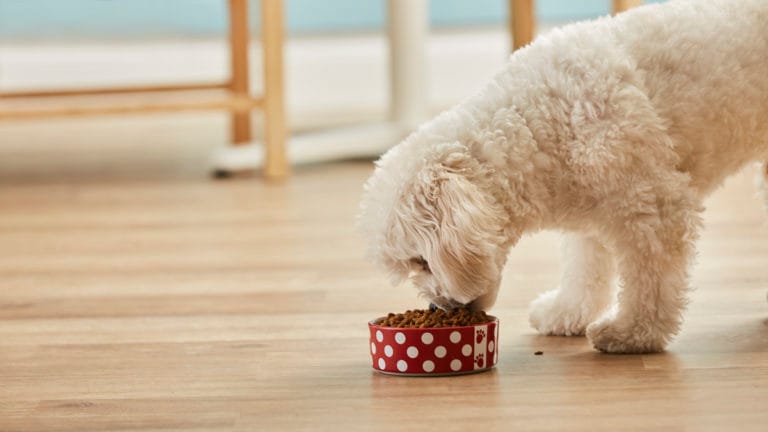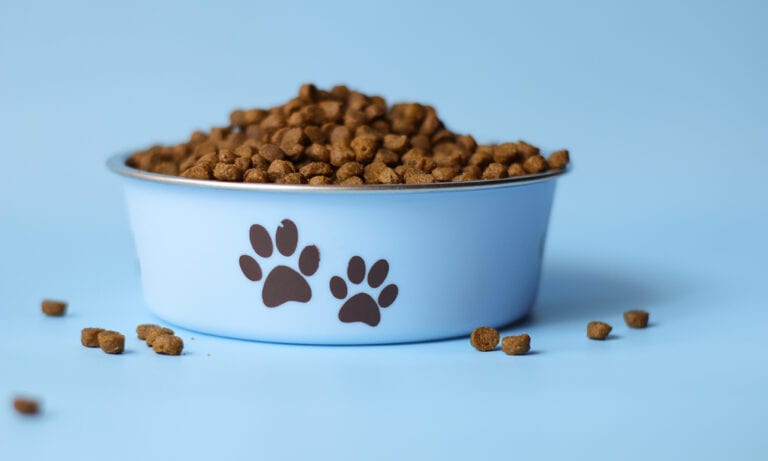Most people have considered different ways to update their own diets from time to time (juice fad, anyone?) — but what they may not have considered is that their pets could likely use a diet revamp every now and then, as well.
For example, older pets may benefit from diets higher in omega-3s (which support joint, heart and brain health in aging pets) while pets with dry, flaky skin can benefit from fish-based diets, says Judy Morgan, DVM. Additionally, she says that pets with chronic disease (like diabetes, kidney disease or bladder stones) will likely benefit from a modified diet to address and help with those issues. “In other words, if your pet is surviving, but not thriving, it’s probably time for a change,” she adds.
Other signs your pet might benefit from a diet tune-up include the lack of a lustrous coat, issues with or disinterest in food and weight loss or weight gain, says Stephanie Liff, DVM, of Pure Paws Veterinary Clinic. It’s important to keep your veterinarian involved in any conversation about diet, says Liff, but once you’ve done so, be aware that a diet change could be forthcoming.
Your vet will likely have suggestions based specifically on your own pet’s needs —unbalanced diets can be dangerous and could even contribute to long-term health problems, says Morgan — but the following are a few common ways to revamp your pet’s diet:
Up the Fruit and Veggie Intake

It’s a simple concept, but rather than a whole diet change, why not try including some more healthy fruits and veggies into your pet’s current diet? Adding lightly-cooked or pureed vegetables—like broccoli, cauliflower and mushrooms—to your pet’s diet can help ward off diseases such as cancer, Morgan says.
Fresh fruits and vegetables — except grapes, raisins and onions, which are toxic — make wonderful treats and snacks, too, Morgan adds. So, instead of feeding your pup a store-bought treat, reach for a piece of melon, apple, pear, cucumber or banana instead. “Your pet might even like frozen blueberries or green beans,” Morgan says. “Why not make treat time healthy?”
Include an Egg

Adding an egg a day to your dog’s diet will add healthy protein to their meals, along with vitamins A, D, E and K, says Morgan. “Eggs are great for pets with anemia, a dull coat, or a young pet with poor bone growth,” she adds.
Just make sure you cook your pet’s egg before feeding it to them. “Raw eggs, especially raw egg whites, can interfere with certain metabolic functions,” says Jerry Klein, DVM, chief veterinary officer with the American Kennel Club. “Hard boiled eggs are good because they don’t have the added butter or oil used in frying eggs.”
If you are using fried eggs, Klein suggests keeping the amount of oil or butter used to a minimum, and egg shells, unless finely ground, should not be fed to dogs as they can become lodged in the throat or intestine.
Bowl Up Some Broth

If your pet suffers from inflammatory bowel disease or has allergy issues, Morgan suggests adding bone broth to their meals, which can help mitigate bowel problems and both food and environmental allergies.
Curb the Carbs

An especially good tip for pets with diabetes, a diet low in carbohydrates can help pets to manage their blood sugar and decrease insulin requirements. Morgan suggests giving pets with diabetes canned food, as dry kibble can be very high in carbohydrates.
Scoop on the Sardines

Believe it or not, sardines are a super food containing vitamin D and omega-3 fatty acids in high quantities, says Morgan. “They’re also low in calories and make a great add-in for pets trying to lose weight or seniors that need extra omega-3s.”
If you’re interested in adding sardines to your pet’s diet, be aware of how they’re packaged, and don’t use those packaged with oil or with added sodium, Klein says. “Fresh, cooked sardines may be better than canned, if they are available.”
Layer on the Leaves

Dark leafy greens like kale, Swiss chard and collards are great for pets with liver disease, Morgan says. Just remember to chop up any leafy products or puree them before feeding them to your pet, says Klein, and be sure to introduce them slowly into your pet’s diet to avoid any stomach upset.
Opt for Organ Meats

Morgan feeds organ meats to her own pets, and uses the saying, “like feeds like” to determine what to feed. For example, she says, a pet with heart disease might benefit from eating cooked heart meat.
“Heart contains high levels of the amino acids that keep the heart healthy — taurine and carnitine. Small amounts of liver are also healthy, but [should comprise] no more than five to ten percent of the total diet,” she says.
Try Some Tripe

If you can get past the smell of tripe (stomach lining, usually from cattle), it has super-food benefits for any pet, even healthy ones, Morgan says. Green tripe, in particular, may be beneficial for dogs with kidney disease, she adds.
“It has the lowest phosphorous content of any meat protein, which is an important consideration for these pets,” says Morgan. “It needs to be green tripe, though, which is full of natural digestive enzymes and probiotics.”
Go Golden

Golden paste — which is made with turmeric, black pepper, coconut oil and Ceylon cinnamon — can be a powerful anti-inflammatory and cancer-fighting supplement, says Morgan. She likes to make a batch, freeze it in silicon ice cube trays, then pop them out one at a time to add to her pets’ meals.
Pile on Pumpkin

For digestive issues, Morgan suggests adding some canned organic pumpkin to your pet’s diet. “It provides soluble and insoluble fibers needed to feed the good bacteria in the bowel,” she says. “It can help treat diarrhea or constipation, and is also high in beta-carotene, which is great for eye health.”
Try pureed pumpkin that doesn’t include added salt, sugar or other spices, says Klein. Or, if you opt for fresh pumpkin, be sure to remove all seeds and the rind, since both could become lodged in your pet’s throat or intestine. Regardless of what type you use, try not to overload your pet’s plate with it.
“For a small dog, a teaspoon of pumpkin puree can is all that is needed,” he adds. “For larger dogs, a tablespoon or slightly more is a good addition.”
Remember that any time you’re changing your pet’s food, it’s best to include a transition phase.
“This means that you mix the old and new food and then gradually, over the course of seven to 10 days, phase out the old food and increase the volume of the new food until you’re feeding on the new diet,” says Liff. “This will help alleviate issues with diarrhea from an acute diet change.”
Cheryl Lock
Share:









